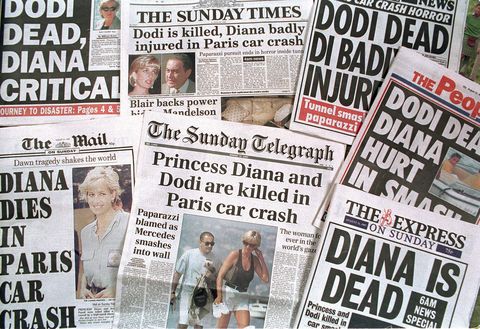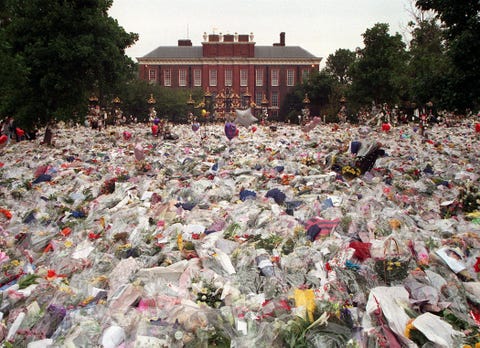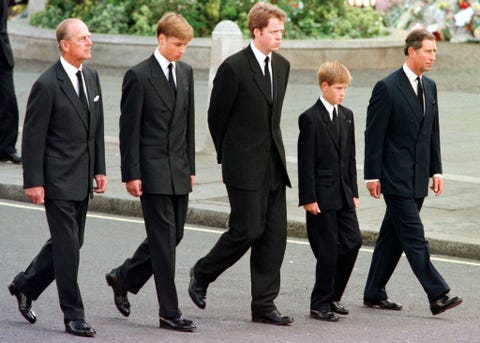Products You May Like
The phone calls came in the early hours of an August Sunday morning when a monumental news story was the last thing anyone was expecting. Princess Diana has been in an accident in a Paris tunnel, come into the newsroom immediately. The messages, from editors and news desks, gave journalists in Paris and London an abrupt jolt. The next hours were filled with frenzied sourcing, rushed calls, and muddling through confusion before the announcement came that Diana had been killed.
Newspaper reporters and anchors jumped out of bed. “I was asleep and the phone rang and it was the foreign desk in New York calling to tell me that Diana had been in an accident, a bad accident, in Paris. I think they knew at the time that Dodi was dead,” recalls Marcy McGinnis, who led CBS News’s London bureau at the time. “It was late but I started to call people to get into the office because I knew that whether she died or not, and it didn’t even enter my mind that she would die, this was a huge story.”
As teams began their coverage, they had few details about the car crash, which occurred when a Mercedes carrying Princess Diana, her boyfriend Dodi al-Fayed, his bodyguard, and driver Henri Paul, crashed into a column in a Paris tunnel, and little way of knowing the degree of gravity with which to approach the story. “I was driving up the road to go to work and I don’t know what it was, I just went back because the jacket I had had on was a buttercup yellow color and I thought no, I’ll just go back because I want to be respectful,” says Sky News anchor Kay Burley.
“If I said anything wrong, my head would be on the block.” — Nik Gowing
BBC’s Nik Gowing was on the air an hour and 20 minutes after receiving the call, arriving to a nearly empty studio at a time when the station wouldn’t normally be airing coverage. With only two other people in the room, including an executive editor, he was experiencing the story develop at the same time that he was presenting on air. “I was conscious that if I said anything wrong then my head would be on the block and the BBC would be taken apart,” he explains. Without mobile phones, calls were going out to nightclubs and restaurants as the team tried to pinpoint where sources might be.
Gowing remained on live TV for seven hours. “I was very sober as I was doing all this. I’ve been in so many crisis moments. My heart rate slows down when I feel I’m in control and that’s what I felt that night,” he recalls. “But now I know that Buckingham Palace and the Queen’s household up in Balmoral Castle in Scotland, they were watching me giving them information about their daughter-in-law. So was Tony Blair and his wife, Cherie.” A snippet of his coverage can be seen in the first minutes of the 2006 film The Queen.
Once she arrived in the newsroom, Burley began reading updates from the news wire service. “I had soaking wet hair and I was just reading copy. It was still saying that Dodi had sadly died but Diana had hurt her leg and she was being taken to hospital,” explains Burley. She learned that barriers were being put up around the Pitié-Salpêtrière hospital, where Diana had been taken, and that the plane of Foreign Secretary Robin Cook had been grounded in the Philippines, signs that the situation was grave. “I ran to makeup, one of the girls did my face and one did my hair and about ten minutes later it was around about six o’clock London time. There was no internet to speak of at that time in the newsroom, but I did have the wire service in front of me and my producer said to me, ‘Just take a deep breath, look down, and read what you’ve got in front of you.’ That was the announcement by the press association that Diana Princess of Wales had died. It still makes me a bit upset now actually thinking about it.”
Gowing, whose announcement became an unforgettable moment for millions of Britons, learned that Diana was dead 50 minutes before he received the official confirmation that would allow him to tell the world. “What I’ve discovered since is that people knew when I knew she was dead because I had to change my voice and the way I looked. I had to make it clear that I was still very much on top of the information and that there might be something coming but I couldn’t confirm it until someone said we can now confirm as the BBC that she is dead.”
The news that Diana had been killed sent news outlets into high gear. At CBS, that meant preparing for one of the largest stories they’d ever cover. “It turned into, oh my god, now this is the hugest story ever. That means Dan Rather was going to come over and my bureau which consists normally of 35 and 50 people would going to grow to be 150 people. So that involves all the logistics of that kind of an influx,” says McGinnis. “I said to myself this is the biggest story I’m ever going to cover. Little did I know 9/11 was going to happen three years later.”
Diana and her personal life made headlines on any ordinary day. The circumstances of her death and the tumultuous years preceding made for a story of unprecedented scope. For if the story of Diana was one that fascinated the press, it was also one that was shaped by it. “Diana was a creature of media. She might have been shy but from a very, very early age, 19, she figured out that she could go directly to the people and bypass all the rules and the restrictions of the monarchy with photo ops and leaking to reporters,” argues Roxanne Roberts, who reported on the story for The Washington Post. “It is the defining aspect of Diana 25 years later, how directly she used the media, how she won people’s hearts, how she became the people’s princess by making sure that she gave the people what they needed her to be.”
The press’s overwhelming scrutiny of Diana has had painful reverberations that can very much be felt today. In 2021, Prince William posted a video speaking about his mother’s seismic 1995 BBC interview with journalist Martin Bashir. It was later revealed that Bashir manufactured evidence to deceive Diana into agreeing to the sit down, in which the princess spoke about her eating disorders and her husband’s infidelity, uttering the unforgettable line, “There were three of us in this marriage.”
In the video, which came after the release of a report into Bashir’s actions, William addressed the degree to which Diana was damaged by the interview. “It brings indescribable sadness to know that the BBC’s failures contributed significantly to her fear, paranoia and isolation that I remember from those final years with her.” Prince Harry issued a statement that was even more clear. “The ripple effect of a culture of exploitation and unethical practices ultimately took her life,” he said.
The impact Bashir’s interview had on Diana’s sons and the greater royal family can’t be understated. “Twenty-five years on, the BBC and the royal family are still very bitter about how it was handled,” Gowing explained. “There’s no doubt that it soured relations between the BBC in particular and the royal family and it’s taken that long to try and rectify them.
After the immediate shock of Diana’s death wore off, reporting into the cause of the crash, the driver’s blood alcohol level, and the role played by the paparazzi, who followed the car on motorcycles, continued on. Reporters from American and British outlets ran into obstacles reporting from France, where the norms on journalistic access were often confusing to them. “I learned a lot but certainly a lot of other journalists did too, about how information flows perhaps. The French government put a tight lid on all the information on the story from the beginning when they wouldn’t even confirm that it was Princess Diana in the car,” says Jim Bittermann, CNN’s Paris-based Senior International Correspondent. “There was a great deal of pressure on all the journalists to find out as much information as possible.”
“It was the only story in Britain and almost the only story in the United States.” — Roxanne Roberts
And the information ultimately being sought was who or what could be blamed for the accident. The cause of the crash was eventually determined to be the intoxication of Paul, who was also traveling a dangerously high speed. The acting security director of the Ritz Hotel, where Diana and Dodi had been dining that evening, he was driving the couple that night and had a blood alcohol level was three times the legal limit at the time of the accident. Craig Whitney, then The New York Times’ Paris bureau chief, spent weeks chasing down leads and separating fact from rumor, determining just what happened the night of the accident and investigating Paul’s background. “It was rather hard to get the details correctly,” he says. “The authorities were rather sketchy at times on how much detail they would release. But in all the years since I’ve not seen any evidence turn up that, yes, indeed, there were photographers who were messing around right in front of the car before the accident or anything to contradict the basic lines of the car crashed because the driver lost control and he was way drunk.” He notes today that, somewhat strangely, he and a Times reporter were unable to find anyone who witnessed Paul drinking in the hours before the accident.
One can’t help but consider how different the tragedy would have been covered were it to have happened today. “It would have been incredibly complicated if there had been Twitter, incredibly complicated if there had been FaceTime. There would have been a lot of video around of the awfulness of the car and probably you’d be able to see Princess Diana in it,” says Gowing. “I think to run and run and run images of something awful, a crumpled Mercedes car sitting in a dark underpass with at least two bodies inside would have been awful.”
As time went on, the nature of the story seemed to shift away from the facts of what had happed to a focus on the magnitude of feeling. “It was not a difficult story to cover in the sense that it was everywhere. It was the only thing anybody was talking about. In many ways, it was the only story in Britain and it was almost the only story in the United States,” says Roberts. “What struck me was this outsized expression of grief. The British, as a general rule, pride themselves on being in control of their emotions and sort of stiff upper lip in handling whatever life throws at them. This was just pure uncensored grief.”
It’s hard to imagine anything like the emotional, much less the literal, coming together experienced by the British public occurring in the present day, Roberts says. “Today any death like that and the biggest one I can think of was Kobe Bryant, a celebrity figure, all of that played out online from the earliest reports to every bit of information and every opinion and all the tributes that poured in. It wasn’t the kind of physical bonding that happened because everyone went to the front of Kensington Palace.”
Six days after her death, Diana’s funeral procession traveled from Kensington Palace to Westminster Abbey. Photos of Princes Harry and William following behind the casket became indelible images of heartbreak. Even seasoned journalists, well accustomed to tragic stories, found themselves struck by the sadness of the story. Katie Couric, whose young daughters would lose their father only months later, broke down in tears live on NBC. “I remember us going off the air [after the funeral] and knowing that was the last broadcast after this whole week and all of a sudden tears started coming out of my eyes. People were going, ‘What’s the matter, what’s the matter?’ I think it was just all that pent up emotion of such an incredible story,” says McGinnis. “The day after everything ended, the funeral was over and all that, I did take a walk over to Kensington Palace and the scene of the flowers. If you think about one little bouquet of flowers, what little space it takes up and when you walked over there, flowers were easily three and four and five feet high. That’s how many thousands of bouquets there were.”
“It was just an outpouring of grief. Was it hysteria? I don’t think so. I think people were genuinely devastated that Diana had died in such a brutal way,” recalls Burley. “Alistair Campbell who was [Tony Blair’s] head of media said when Blair called Diana the People’s Princess he thought that he’d gone over the top. But actually that’s exactly how she came to be known and he hit the room just right.”
Adrienne Gaffney is an associate editor at ELLE who previously worked at WSJ Magazine and Vanity Fair.


